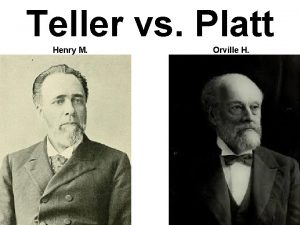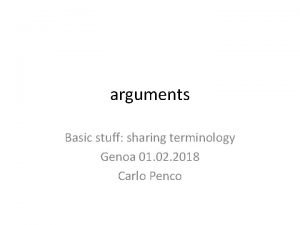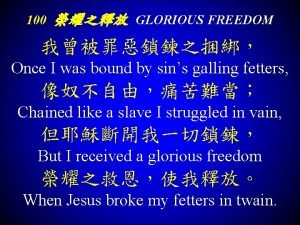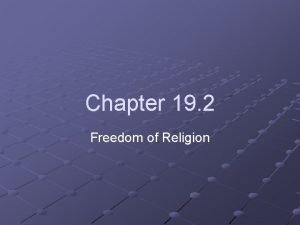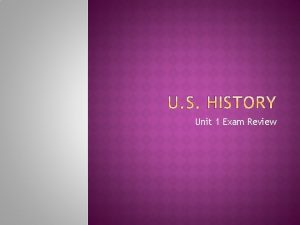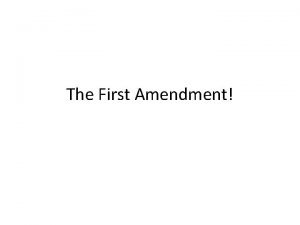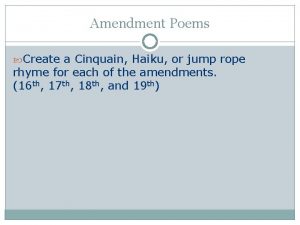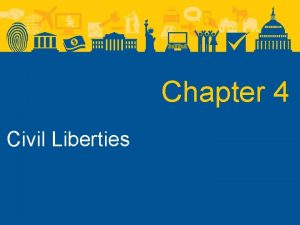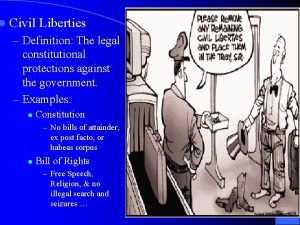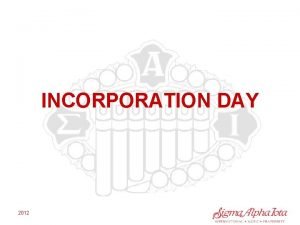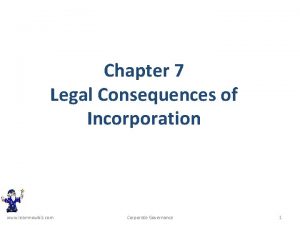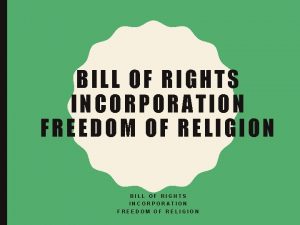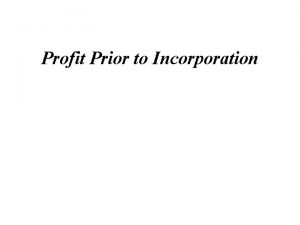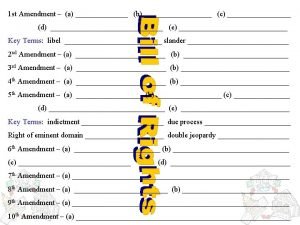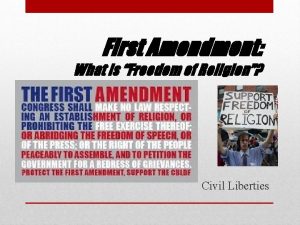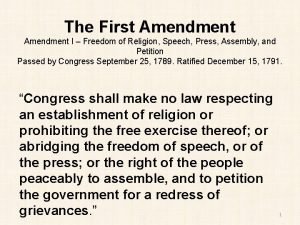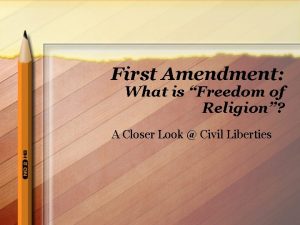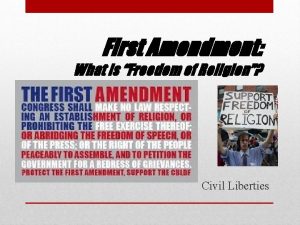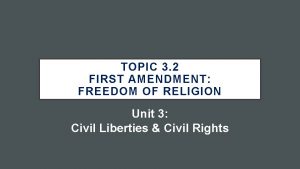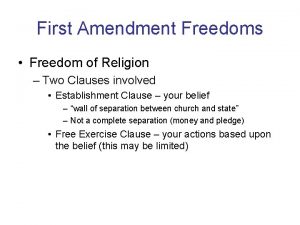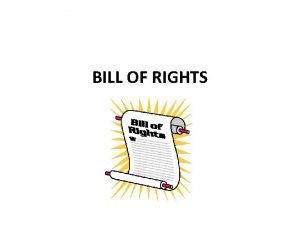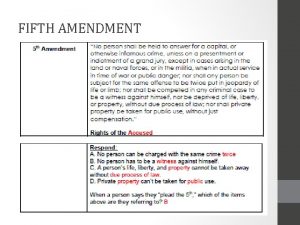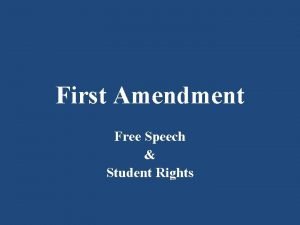Incorporation of the First Amendment Freedom of Religion















- Slides: 15

Incorporation of the First Amendment

Freedom of Religion The Establishment Clause The Free Exercise Clause Which one of these religious freedoms is the most important to you?

The Establishment Clause �Jefferson wrote that this clause created “a wall of separation between Church and State” �Forbids the government from supporting any particular religion.

Free Exercise Clause �Prohibits the government from interfering practice of religion. with the

The Establishment Clause �School prayer �Engle v Vitale (1962) � State sponsored prayer violated the Establishment Clause and “breaks the constitutional wall of separation between Church and State. ” �Wallace v Jaffree (1985) � Ruled that moment of silence was unconstitutional if intended for prayer. �Aid to parochial schools �Lemon v Kurtzman (1971) � Aid to church-related schools must meet the “Lemon Test” by passing these 3 test 1. Must have secular purpose 2. Government can neither advance nor inhibit religion 3. Government action must not foster “excessive entanglement” between government and religion.

The Free Exercise Clause �This clause guarantees each person the right to believe what they want; however, a religion cannot make an act legal that would otherwise be illegal. �Oregon v Smith (1990) � Outlawed illegal drugs to be used for religious practices �Limits on Free Exercise: �Reynolds v US (1879) � Supreme court ruled polygamy was unconstitutional because “beliefs would be superior to the law of the land. ” �Wisconsin v Yoder () � Amish people can remove children from school for religious purposes.

First Amendment (Religion) - FRQ �The First Amendment contains two clauses relating to the freedom of religion. For each of the following cases, identify the First Amendment clause upon which the US Supreme Court based its decision and describe the court’s decision in that case. a) � � b) Engle v Vital Reynolds v US Oregon v Smith Lemon v Kurtzman Many of the Supreme Court decisions have caused controversy in the United States. Describe two ways in which other political institutions might limit the impact of those decisions.

First Amendment Freedom of Speech

Get out your Court Case Notecards National Supremacy Cases Incorporation Doctrine Cases Marbury v Madison Barron v Baltimore Mc. Culloch v Maryland Gitlow v New York Gibbons v Ogden Freedom of Speech and Press Freedom of Religion Rights of the Accused Rights to Privacy

Freedom of Speech �The Framers believed that the right to free speech is a fundamental natural right. �The guarantees of free speech are intended to protect unpopular views and the right of the minority.

The “Clear & Present Danger” Test �The Espionage Act of 1917 prevented forms of dissent that are harmful to the nation’s war effort. Charles Schenck mailed 15, 000 anti-war leaflets urging readers to resist the military draft. �Schenck v US (1919) � Every act depends on the circumstances � “Cannot yell fire in a theatre. . . ” � Created a precedent that 1 st Amendment guarantees of free speech are not absolute. �Brandenburg v Ohio (1969) advocacy (supporting the KKK is free speech) � advocacy is different than action (action = lawlessness) � Limited clear and present danger by ruling “government could punish only if action directly inciting lawless action” �

Limits on Free Speech 1. Libel and Slander � Libel = written defamation and Slander = spoken defamation � New York Times v Sullivan (1964) � Ruled that statements about public figures are libelous only when both false and purposely malicious. 2. Obscenity � Roth v US (1957) � Obscenity is not protected by free speech or press � Miller v California (1973) � The Court set a list of test for obscenity, but it is up to each community to implement these tests.

Limits on Free Speech 3. Symbolic Speech � Tinker v Des Moines (1969) � Symbolic speech is protected by the 1 st Amendment freedoms and “students and teachers do not shed their constitutional rights… at the school house gate. ” � Texas v Johnson (1989) � The court ruled that flag burning is a form of symbolic speech and is protected. � The court has since ruled that the 1 st Amendment does not protect actions intended to incite illegal actions.

First Amendment Freedom of the Press

Prior Restraint �Prior Restraint is the attempt to limit freedom of the press by preventing material from being printed; thus, a form of censorship. Both of these cases tests the idea of prior restraint. �New York Times Co. v US (1971) � Court allowed printing of Pentagon Papers because they could not find any harm �Hazelwood �School v Kuhlmeier (1988) administrators can exercise censorship in school sponsor activities.
 Teller and platt amendments
Teller and platt amendments Positive freedom negative freedom
Positive freedom negative freedom Glorious freedom wonderful freedom
Glorious freedom wonderful freedom Chapter 19 section 2 freedom of religion
Chapter 19 section 2 freedom of religion Secneer
Secneer Which statement best summarizes the water cycle?
Which statement best summarizes the water cycle? Splc first amendment quiz
Splc first amendment quiz 4th amendment poem
4th amendment poem Chapter 4 civil liberties
Chapter 4 civil liberties Civil liberties first amendment freedoms
Civil liberties first amendment freedoms Nc first in freedom
Nc first in freedom Bill of rightts
Bill of rightts Selective incorporation definition
Selective incorporation definition Incorporation day.
Incorporation day. Consequences of incorporation
Consequences of incorporation Alpha kappa alpha incorporation date
Alpha kappa alpha incorporation date
